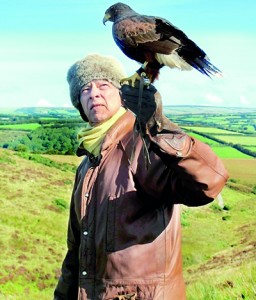Hawking on Exmoor
 Nigel Penfold lives at 21 Broad Close, North Molton in Devon. He is a falconer and takes clients out onto the moors near Withypool with his two Harris hawks – Cassius and Lady Macbeth.
Nigel Penfold lives at 21 Broad Close, North Molton in Devon. He is a falconer and takes clients out onto the moors near Withypool with his two Harris hawks – Cassius and Lady Macbeth.
Falconry uses “long winged birds” … i.e., not surprisingly, falcons. The prey is usually pheasant, grouse or partridge. Typically the birds will be carried hooded while the falconer, often with a dog, usually a pointer, gets into position and releases the falcon. She climbs high and waits above the falconer. The prey is flushed – and the falcon swoops.
Hawking uses “short” or “broad” winged birds. The Harris hawk (featured: Parabuteo Unicinctus) is the most common in the United Kingdom because of its biddable character and intelligence. The proper title of one who hunts with falcons is “falconer”. One who hunts with a hawk is an “austringer”. This ancient word, seldom used today, has now incorrectly been replaced with the word “falconer”.
One afternoon this autumn I was treated to a spectacular display of hawking on Exmoor in Devon. It reminded me of the Victorian explorer Sir Richard Burton’s description of his hunting experiences in Sind in his treasured book Falconry in the Valley of the Indus – published in 1852 and not reprinted and co-published until 1997 by the Department of Culture in the Government of Sindh, and Oxford University Press. His evocation of hawks and falcons, and the people dedicated to training them, his delineation of the language and technique of falconry, and his sensitive understanding of the joys of the sport, are unmatched.
Falconry almost certainly began in Mesopotamia, or in Mongolia and China as early as 2000 B.C. The falcon was a symbolic bird of ancient Mongol tribes and was probably introduced to Europe around 400 A.D. when the Huns and Alans invaded from the East. Historically, falconry was a popular sport and status symbol among the nobles of medieval Europe. In the Middle East and Mongolia it was restricted to the noble classes because of the prerequisite commitment of time, money and space. It remained a status symbol long after it was no longer practical.
The historical significance of falconry may be under-represented due to a lack of surviving literary evidence especially from non-literate nomadic and non-agrarian societies. However we do know that within nomadic societies like the Bedouin, falconry was not practised for recreation by noblemen but, instead, falcons were trapped and hunted on small game during the winter months to supplement a very limited diet.
It is extraordinary that this sport – one of the oldest in the world and full of what Sir Richard Burton described as the “noble art” – still has an enormous following in the Middle East, and more recently (beginning of the 20th century) in the United States of America. It reached its zenith in the 17th century but faded in the late 18th and 19th centuries as firearms became the popular tool of choice for hunting.
Hawking on Exmoor provided one of the most exciting afternoons I have ever had.
Follow @timesonlinelk
comments powered by Disqus
























